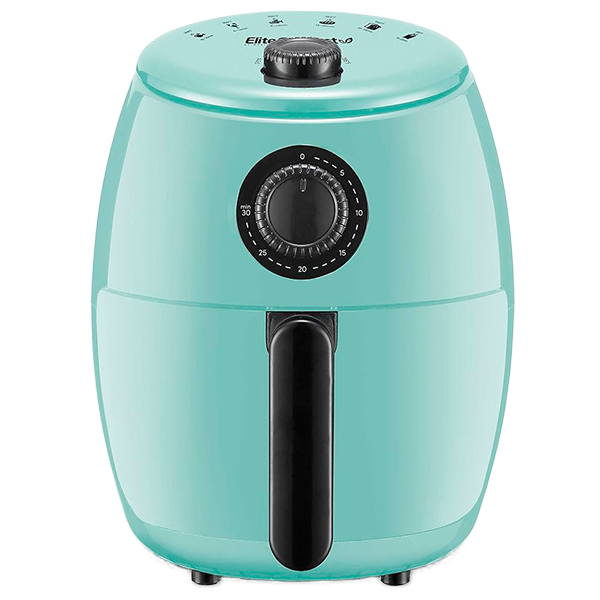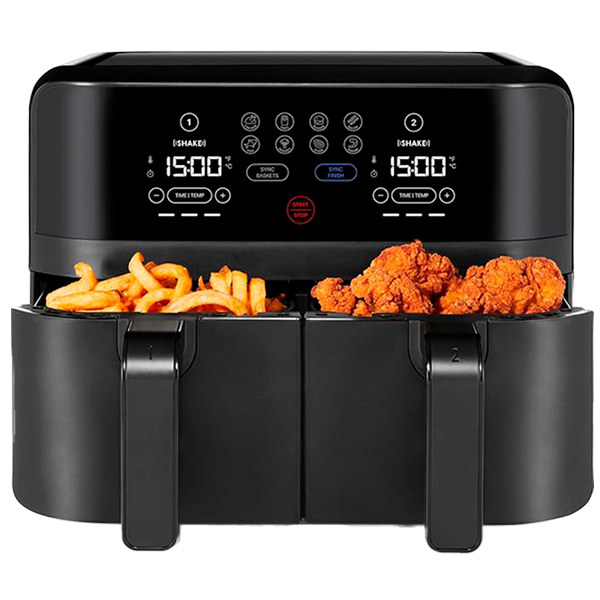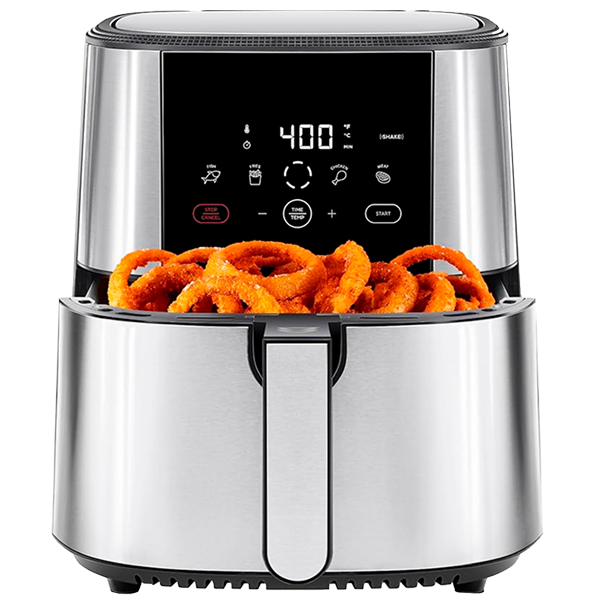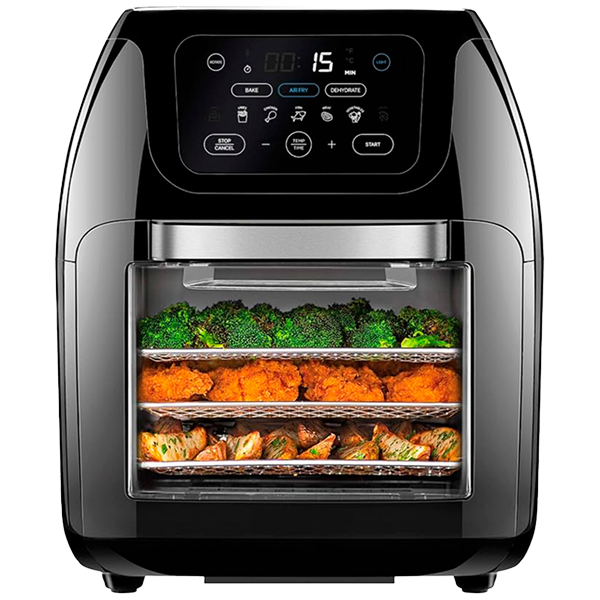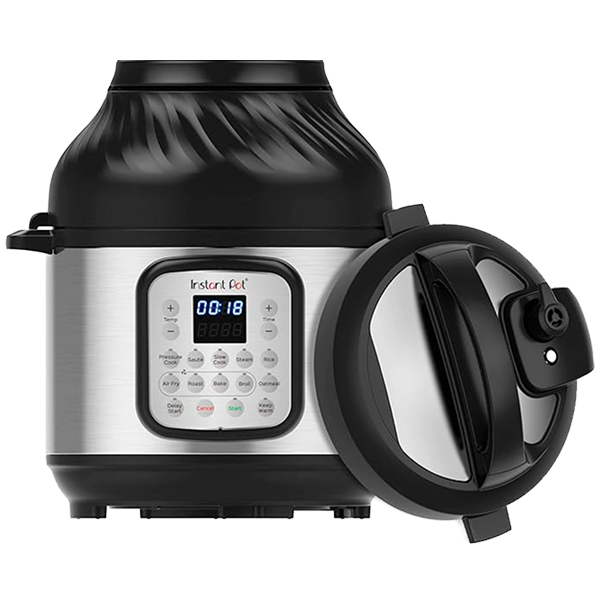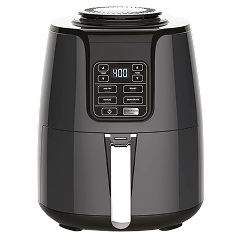Instant Pot is among the most popular air fryer brands out there. While one might think of those multi-cookers with air frying capabilities, the brand offers just about every type of air fryer out there.
So figuring out the best air fryer from Instant Pot is a little tough because the models are so varied. With that in mind, you’ll have to decide what you want out of an air fryer, and what the best air fryer means to you. Maybe you want that multi-cooker versatility. Or maybe you want a simple basket-style model from a well-known brand. Regardless, I’ll lay out how to choose the one that’s right for you and what to look for (and avoid).
How To Choose an Instant Pot Air Fryer
Type of Air Fryer
The first thing one needs to figure out when deciding on an air fryer is the type. When it comes to Instant Pot’s models, you can find just about every form factor.
There are basket-style models that range from four to nine quarts, some of which are perfect for smaller households or those with limited kitchen space. Some of the bigger ones, specifically the dual-compartment models, offer quite a bit of cooking capacity.
Instant Pot also has the larger toaster oven-style models for those who want to either cook multiple things at once – you can stack trays of dishes the way one would in an oven – or might want to cook bigger items, such as a whole chicken. Of the toaster oven-style models available, the capacity ranges from 10 to 18 quarts.
Where Instant Pot really sets itself apart from the competition is in its range of multi-cookers with air frying capabilities along the company’s more traditional pressure cookers and Instant Pots. These models don’t quite have the capacity of the toaster oven-style air fryers as they range between six to eight quarts, but are still good for families and more active cooks thanks to their flexibility.
They can do everything that an Instant Pot can do with pressure cooking, but can also air fry – you just have to use a different lid (included with purchase). If you have limited space, but like to have multiple cooking devices, one of these can save some time with their 2-in-1 functionality, though they are still a bit bigger than a typical basket-style air fryer.
Capacity
Air fryer capacity makes a big difference in how much and what type of food you can cook. Smaller models with less than five quarts are best suited for single servings or small side dishes, such as fries, wings, or vegetables. They work well for individuals or anyone who only plans to use the air fryer occasionally for snacks or add-ons.
Stepping up to the six- to nine-quart range gives you more flexibility. These models can handle enough of a side dish for a small family dinner, or even let you prepare two foods together, like chicken nuggets and fries. For households where the air fryer is used for full meals rather than just sides, this size range is more practical.
Dual-compartment models add another layer of versatility. Each basket usually holds about four to four and a half quarts. While the total capacity isn’t much greater than a standard medium or large air fryer, the advantage is that you can cook two different dishes at once using different times and temperatures.
Toaster oven–style air fryers provide more overall space. Their larger internal design, combined with multiple trays that can be slotted at different heights, makes it possible to cook two dishes simultaneously. The limitation is that both trays must cook at the same temperature and time, but unlike basket models, you can still keep the foods separate.
The reason capacity matters so much is because air fryers cook by circulating hot air around the food. If you crowd the basket or tray, the air can’t reach all sides evenly, which often results in food that’s crispy on one side and soggy on the other. A larger air fryer reduces the risk of overcrowding and improves overall cooking results.
For specific dishes, the size requirement becomes even clearer. A whole chicken, for example, needs a capacity of at least six quarts to fit a five-pound bird comfortably. If you also want to cook vegetables or other sides at the same time, a larger unit is better. For individuals, a three- or four-quart model is usually sufficient, but families or those who rely on their air fryer for full meals will benefit from choosing a larger capacity. In general, it’s better to slightly overestimate than underestimate, since extra space ensures better airflow and more consistent cooking.
Temperature
Most air fryer recipes fall within the same temperature range, so for everyday foods like chicken nuggets, wings, fries, bacon, or even steak, you don’t need to worry too much about temperature settings. Virtually all modern air fryers, including those from Instant Pot, are designed to handle these foods with ease.
Where temperature range becomes important is when you want to branch out into less common uses. For dehydrating foods, such as making dried fruit or beef jerky, the air fryer needs to go as low as 130°F (55°C). On the opposite end, if you plan to sear a steak, caramelize the top of a French Onion Soup, or finish a Crème Brûlée, then you’ll want an air fryer capable of reaching higher heat—ideally up to 450°F (233°C).
In short, if your cooking focuses on standard fried-style dishes, temperature range isn’t a concern. But if you’re interested in dehydrating, browning, or searing, pay close attention to how wide the air fryer’s temperature range is.
Wattage
Wattage is an important metric to consider as it determines how powerful an air fryer is and how quickly it can reach the desired temperature. You would think that every air fryer would come with the necessary amount of power, but you’ll sometimes find no-name air fryers that skimp on having enough power to properly heat their internal capacity quickly and evenly.
To get more specific, a regular six-quart basket-style air fryer should ideally have at least 1,400 Watts, preferably around 1,500 Watts, while toaster oven-style air fryers with larger capacities should have around 1,700 or more.
Luckily, Instant Pot doesn’t compromise the way some knock-off brands might. Even Instant Pot’s smallest four-quart model has 1,600 Watts, with most toaster-oven models around the 1,700 to 1,800 range. The multi-cookers tend to be a little less powerful at around 1,500 Watts, but that is still more than enough.
Controls
When it comes to Instant Pot Air Fryers, the controls are pretty straightforward. You select your time and temperature, presets, or any extra functionality by way of a series of buttons and, often, an included dial.
The thing to consider when it comes to controls on an Instant Pot air fryer is not so much what kind of controls as they’re all fairly similar, but what kind of settings you want available to you. Specifically, you’ll want to think about what modes you need.
Modes are essentially presets on an air fryer. Selecting a Toast or Dehydrate mode doesn’t change how the air fryer functions – multi-cookers with their pressure cooking functionality notwithstanding – but just adjusts the time and temperature at which the air fryer runs.
Still, having different modes available for quick access to certain settings takes some of the guesswork out of choosing the right time and temperature. So, when it comes to controls, decide what functionality is important to you.
Some of the popular modes you’ll see besides Air Fry include Roast, Toast, Dehydrate, Bake, Broil, Reheat, Warm, Proof, to name a few. Multi-cookers add in other modes like pressure cook, slow cook, steam, sauté, and sous vide.
Build
When looking at air fryer build and design, there are a few practical details to keep in mind. One is cleaning. Basket-style air fryers are often the easiest to deal with, since the basket can be lifted out and washed in the sink or, in many cases, the dishwasher (though it’s always best to check the manual first). Toaster oven–style air fryers are slightly more work. While the trays and accessories can be removed and washed, the internal cavity still needs to be wiped down by hand. Multi-cookers add yet another step, as air frying requires an additional lid, which means more parts to clean.
Material choice is another consideration, especially if you’re concerned about exposure to plastics. Many basket-style air fryers have some internal plastic around the heating element and fan. This design raises concerns for some users who want to minimize the chance of microplastics or PFAS exposure while cooking.
A final factor is visibility. With most basket-style and multi-cooker designs, the only way to check on food is to pause cooking and open the unit. Some models, however—both in basket-style and toaster oven-style categories—offer see-through windows and internal lighting. These allow you to monitor your food without interrupting the cooking process.
Extra Features
You might not put extra features at the top of your list when choosing an air fryer, but they should be a consideration. For instance, if you want to cook a whole chicken, only a select few toaster oven models in Instant Pot’s lineup come with a rotisserie spit. Now, you can cook a whole chicken without that extra accessory, but the results are going to be slightly different. Similarly, just one or two models come with a pizza pan.
Beyond just accessories to cook, you generally want to consider safety features. If you like to walk away from your air fryer when in use, look for Auto Shutoff. If you’re worried about issues with temperature control, look for what Instant Pot calls Overheat Protection. It’s worth noting that most of the company’s models come with these safety features. And make sure that if you’re looking at one of the multi-cookers, it comes with a safety locking lid. Having a way to release steam safely is also worth looking for.


